
AstroClocks
per Android

The AstroClocks app shows and simulates famous astronomic clocks on Android devices.
In order to download the program please go to Google Play Store.
Or use this QR code with your smartphone:
Please read the Privacy Policy.
The AstroClocks Android app collects the simulation of some of the most famous astronomical clocks in Europe
The first of these is the Torrazzo clock in Cremona, presented both in the current modern version and in the original version, before the reconstruction. Then the Brescia and Praga ones follow. This last one is also presented in a completely recomputed version that is so shown for the actual latitude as measured by the device.
Individual clocks are accessed via the home page:
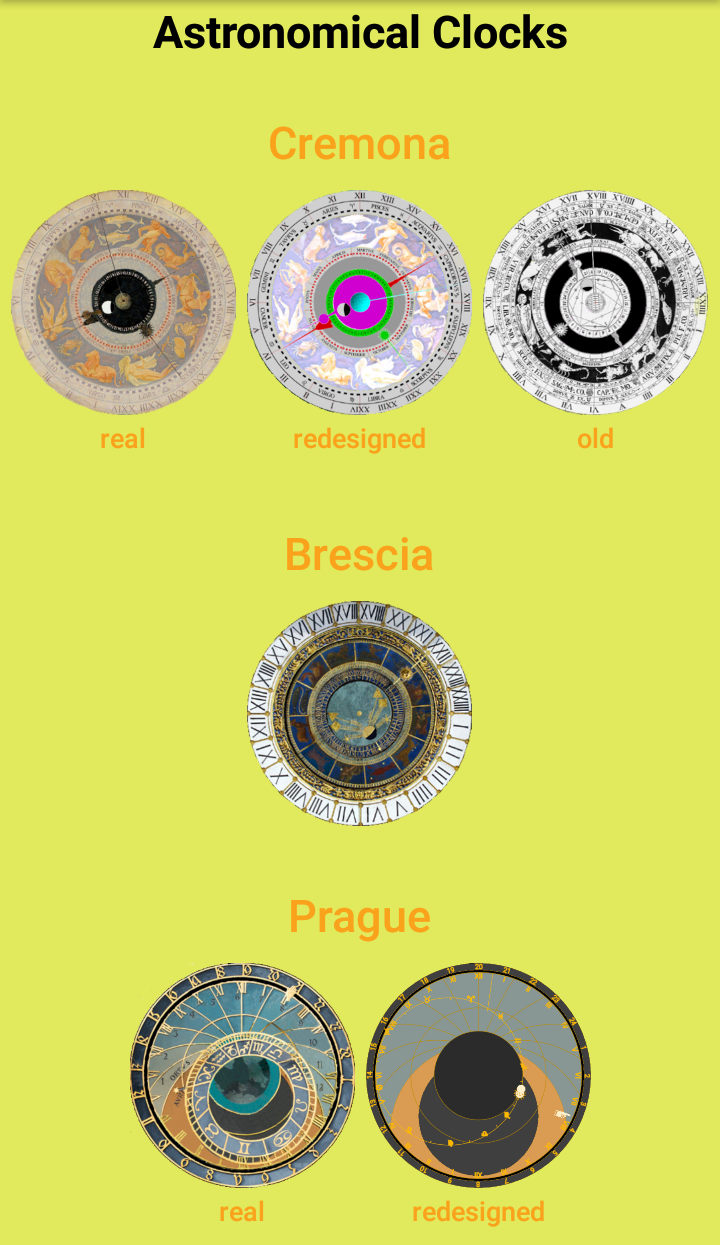
The selected clock opens in continuous mode, i.e. the date is the
current one and the time is updated every second.
The top right menu allows you to change the operation in the
following ways:
-
reset: reset current date and time and proceed with continuous updating of the time
-
stop: stop any automatic modification of the current time and date
-
increment date: simulate a date variation in 1-day steps
-
increment hour: simulate a time variation in 5 minutes steps
-
set hour and date: set the desired date and time
Hand positions are calculated using the most precise methods described by Jean Meeus in the book "Astronomical algorithms".
I have to thank my gnomonist friend Luigi Ghia for giving me the drawings of the moving parts of some of the watches represented here, as well as for encouraging me to proceed with the development of this app.
Astronomical clock of Torrazzo in Cremona
The cathedral of Cremona, built between the 12th and 15th centuries, is flanked by a 110 m high bell tower, called "Torrazzo". In 1583 Giovanni Battista and Giovanni Francesco Dovizioli (father and son) installed an astronomical clock on the "Torrazzo". In 1787 Amicino Ravizza performed a general repair of both the watch and the dial.
The app presents the clock in the actual version, in a redesign of the actual version and finally in its original version i.e. before the restoration made in 1787.
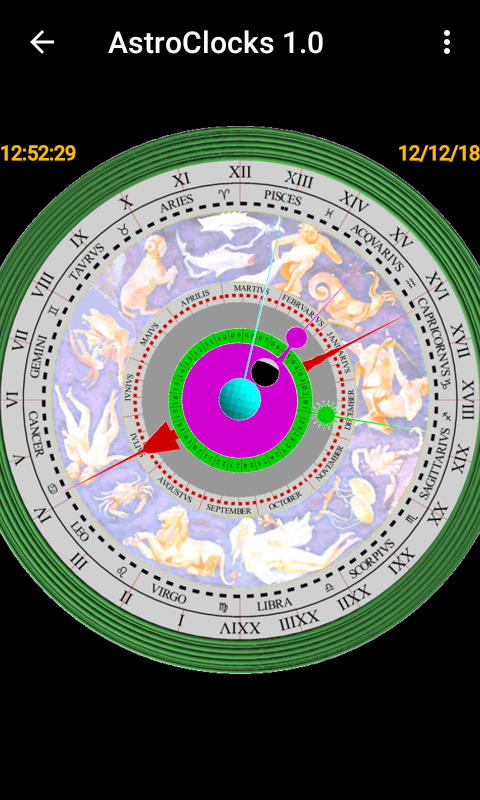
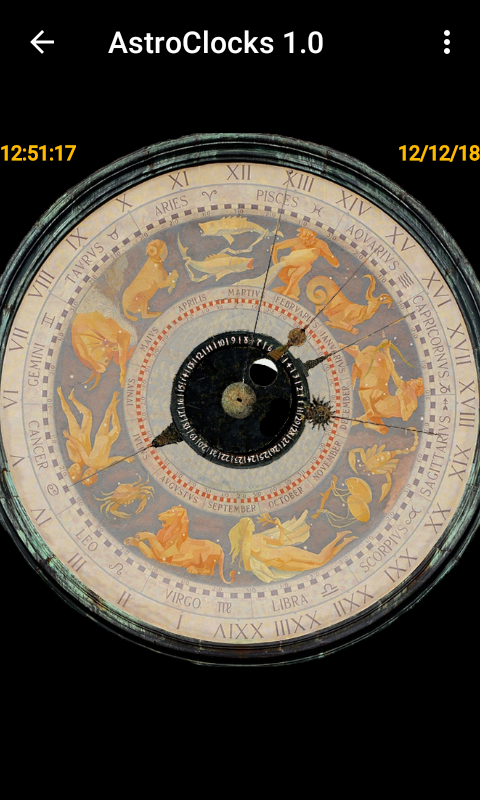
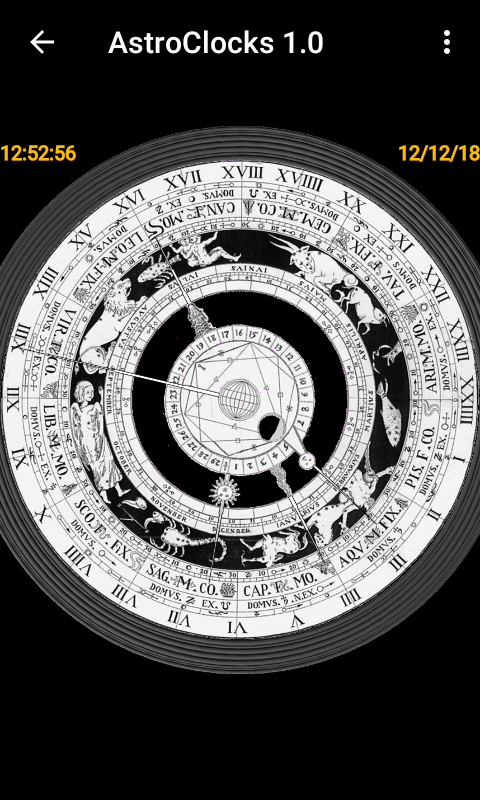
All the three versions show the same information; the original version still shows the 24 hours tick on the sunset position as typical of the italic time clocks, even if it now shows the astronomic time as the other two also do.
The clock shows the following information:
-
current time: the integral hand with the center ball, symbolizing the earth, shows the hour on the outermost circle, with roman digits
-
solar longitude: the small sun hand shows the position of the sun on the ecliptic represented by the 12 zodiacal signs; the involved circles report the name and design of the sign, a scale with a notch every 2 degrees, the scale of the months and days of the year
-
lunar longitude: using a hand with the moon symbol, on the same scales used for the sun hand; the same hand also indicates, on an internal disk, the number of the day in the synodic month and, through a small window on the internal disk, the phase of the moon
-
lunar nodes: the dragon-shaped hand marks the position of the ascending nodes (dragon\'s head) and descendants (dragon\'s tail) of the lunar orbit on the ecliptic; when sun and moon come to be found at these nodes, there is a solar or moon eclipse.
Outside the clock, the app displays the date and time corresponding to the situation displayed by the clock.
As explained in the introduction, the menu commands allow you to set different date and time or to simulate, for educational purposes, a continuous variation of date or time.
Astronomical clock of Piazza della Loggia in Brescia
In Piazza della Loggia, in Brescia, on the tower with a portico, through which you reach the Palazzo del Broletto, there is the astronomical clock. On the roof of the tower, above a platform, there are two copper automata, installed in 1581, equipped with a hammer, which beat the hours on a bronze bell. Due to their presence, the tower is called "Matti delle ore", in the Brescian dialect, "MACC DE LE URE".
The tower was erected between 1540 and 1550 (designed by Lodovico Beretta), while the clock was started in 1544 and finished in December 1546 by Paolo Gennari, di Rezzato.
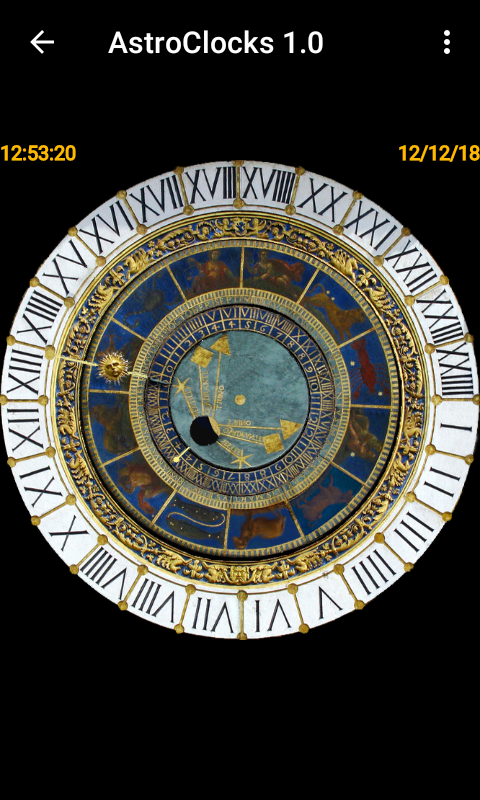
The clock shows the following information:
-
current time: the hand with the sun symbol shows the hour on the outermost circle, with Roman numerals
-
sun longitude: the same hand also shows the position of the sun on the ecliptic represented by the 12 zodiacal signs; these are on an intermediate disk that rotates every sidereal day
-
age and phase of the Moon: a lancet integral with the innermost mobile disk, which makes a rotation on a lunar day, indicates the age of the moon in days; moreover, through a small window on the same internal disk, the phase of the moon is shown
Outside the clock disk, the app shows the date and time corresponding to the situation displayed by the watch.
As explained in the introduction, the menu commands allow you to set different date and time or to simulate, for educational purposes, a continuous variation of date or time.
Astronomical clock of Prague
The clock is positioned on the south side of the municipality of the old town and it is one of the most important attractions of the city.
The mechanism is made of three main elements:
-
the astronomic face: where, in addition to actual time, the positions in the sky of sun and moon, together with several other astronomic information, are shown
-
the animated figures: four figures flanking the clock and set in motion on the hour
-
the months in a year: a calendar plate below the clock showing the 12 months
Here is the description from Wikipedia:
"The oldest part of the Orloj, the mechanical clock and astronomical dial, dates back to 1410 when it was made by clockmaker Mikuláš of Kadaň and Jan Šindel, then later a professor of mathematics and astronomy at Charles University.
The first recorded mention of the clock was on 9 October 1410. Later, presumably around 1490, the calendar dial was added and the clock facade was decorated with gothic sculptures.
In 1552 it was repaired by Jan Taborský (ca 1500–1572), master clockmaker of Klokotská Hora, who also wrote a report of the clock where he wrongly mentioned Hanuš as the maker of this clock.
The clock stopped working many times in the centuries after 1552, and was repaired many times.
In 1629 or 1659 wooden statues were added, and figures of the Apostles were added after a major repair in 1787–1791. During the next major repair in the years 1865–1866 the golden figure of a crowing rooster was added.
The Orloj suffered heavy damage on May 7 and especially May 8, 1945, during the Prague Uprising, when the Nazis fired on the south-west side of the Old Town Square from several armoured vehicles in an unsuccessful attempt to destroy one of the centers of the uprising. The hall and nearby buildings burned along with the wooden sculptures on the clock and the calendar dial face made by Josef Mánes. After significant effort, the machinery was repaired, the wooden Apostles restored by Vojtěch Sucharda, and the Orloj started working again in 1948.
The Orloj was renovated in autumn 2005, when the statues and the lower calendar ring were restored. The wooden statues were covered with a net to keep pigeons away."
The clock is here presented both in the original version (and so computed for a latitude near to 50 degrees) and both redesigned, with a simpler but easier to study shape, computed for the latitude as measured by the device where the app is run.
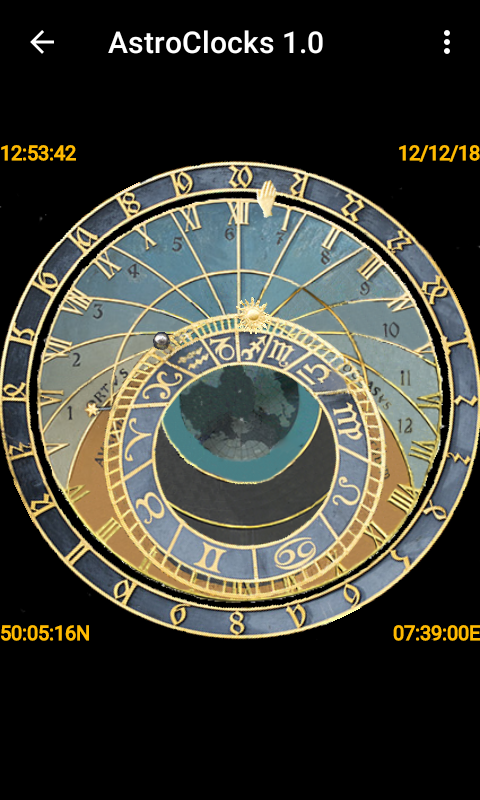
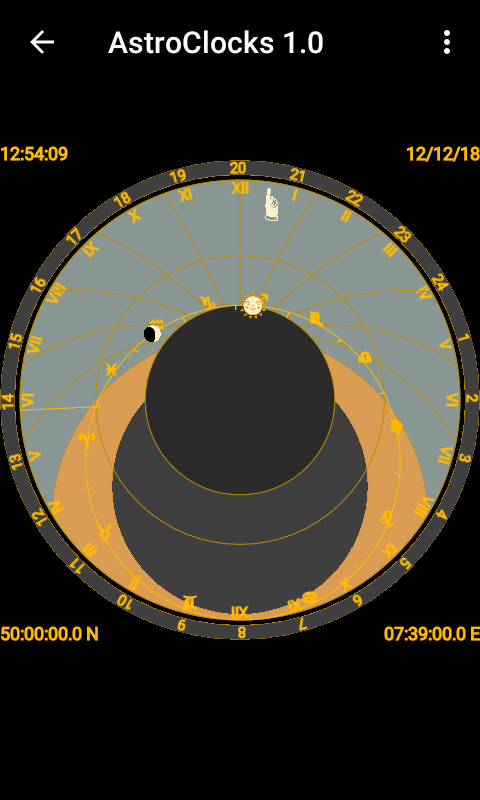
The clock shows the following information:
-
external mobile disc: the most external disc rotates in order to align the italic time 24 (sunset time) with the point where the sun will pass the sunset line in the actual day
-
fixed internal disc: the internal disc shows three concentric circles that represent, from the smaller to the larger, the Tropic of Capricorn, the Equator and the Tropic of Cancer; the lighted part is shown in the top (divided into 12 temporary hours) and the night part is shown in the bottom (with the twilight section enhanced)
-
ecliptic: the ecliptic circle is positioned in accordance to the actual date
-
sun: the sun is placed on the ecliptic ring according to the actual date and time
-
moon: the moon is positioned on the ecliptic ring; depending on the angular moon/sun distance, the moon phase is shown
Outside of the clock disc the app shows the date and time correspondent to the situation that is shown by the clock, together with the geographical coordinates of the simulation (where latitude will always be 50:05:16 N for the original design simulation).
As explained in the introduction, the menu commands allow you to set different date and time or to simulate, for educational purposes, a continuous variation of date or time.
In the redesigned form it is also possible to simulate a different location by changing the geographical coordinates of the position of the clock.
App Preferences
Preferences command shows and lets you modify app settings.
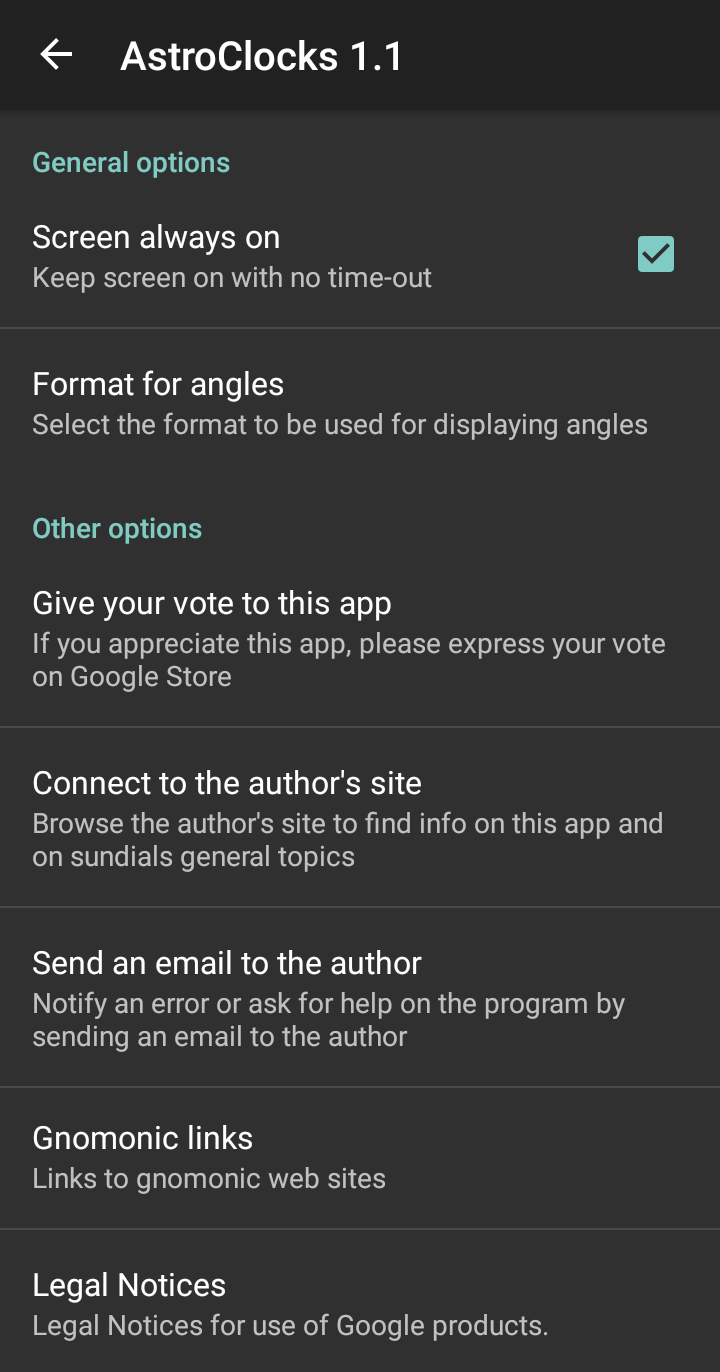
Here are all available choices:
GENERAL OPTIONS
-
Screen always on: keep screen on with no time-out
-
Format for angles: select the format to be used for displaying angles: decimal (x.xxxx) or degrees:minutes:seconds.
OTHER OPTIONS
-
Give your vote to this app: use this command to express your vote on Google Play Store
-
Connect to the author's site: browse the author's site to find info on this app and on sundials general topics
-
Send an email to the author: notify an error or ask for help on the program by sending an email to the author
-
Gnomonic links: show a list of web sites with gnomonic contents
-
Legal notices: legal notices for using the Google products included in AstroClocks
Updated on domenica 23 dicembre 2018
